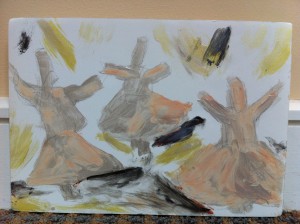Whose Islam? Sufism and Religious Expression Through Music and Dance
Materials: acrylic paint on foam board
The Sufi tradition transcends the Sunni-Shiite divide, though its status as legitimate Islamic practice is highly contentious. There are both Sunnis and Shia who identify as Sufi, though there are many who do not consider Sufis to be Muslims at all. In contrast, there are many who believe there is no other way of being a Muslim. They argue Sufism is at the heart of Islam.
The word Sufi is derived from the Arabic word suf, which means wool. The early Sufi mystics in Iraq wore wool garments, and the term has broadened to include any person who has a mystical or spiritual perspective. The Arabic word ‘faqir’ and the Persian word ‘darwish’ are also terms for Sufism, and these words connote a sense of poverty or absence. They do not connote poverty in the literal sense, but rather point to the Sufi idea that true richness and opulence comes in the next world with God.
The Sufi tradition centers on the idea that one can know God through experience, just as the prophet Mohammad did. Every human being can experience the mi’raj and have personal knowledge of the divine. For Sufis, the zahir are the external, physical and sensory aspects of life that rely on the intellect and contrast with the batin, internal and spiritual aspects of life that contain eternal and immaterial truths. Sufis must follow “the spiritual path” (Tariqah) in order to experience the “the real” (Haqiqah). The biggest obstacle along the path to experiencing God is the ego. There can only be one ego, and that is God’s.
For Sufis, God is closer to us than ourselves, a notion encapsulated in the popular saying, “God is closer to us than the neck vein.” We can see God everywhere and in all creations, in trees, plants, flowers, and even human beings. Yet simply taking note of God’s physical creation is zahir, looking at material or external entities. For Sufis, everything has a spiritual truth, and this truth is revealed when we see not with our eyes, which is physically seeing, but when we see with the heart. When we get behind the wall of zahir, and transcend the physical, we reach the Haqiqah, the eternal and where God lies.
For Sufis, this ecstasy and understanding of God is achieved through experience, rather than the intellect. The process of achieving “ecstatic consciousness” is called wajd, defined as “ecstasy and ardor,” “finding,” and “being” (Lewisohn, “The sacred music of Islam,” p. 22). According to the Sufi tradition, wajd is achieved through sama, or listening to music and poetry. Wajd is a spiritual sensation, an “exit from self-existence and an entrance into egoless consciousness” (Lewisohn).
For Sufis, there are four types of sama (translated as audition or listening): the lawful, the permitted, the disapproved, and the forbidden (Ernst, “Sufi Music and Dance,” p. 181). The acceptability of music (within Islamic law) is measured by the listener’s activity, rather than the performance. Sufis must be in a certain spiritual time, place, and company in order to properly receive music and have a chance at experiencing ecstasy.
The whirling dervishes, a form of Sufi dance and worship, have come under fire from Sufi critics, who view music and dance as self-indulgent and impious pleasure. This tension has been exacerbated by Western fascination with the whirling dervishes and other Sufi music and dance traditions. Critics have charged that these traditions are being used for tourist entertainment and commercial gain.
Yet Sufis argue that sama is not for everyone, and only people with extensive spiritual training should participate in these practices. It is true that for the general public, sama can be dangerous and ego-centric. But given a certain level of spiritual enlightenment, the whirling dervishes are experiential, a way to lose yourself and achieve wajd.
The whirling dervishes show that there are numerous mediums and avenues for connecting with God, outside of prayer. In my painting, depicting three participants in the whirling dervishes, the figures are painted in a shiny white and silver to represent cleanliness and purity, and ultimately, understanding of God. The black at the bottom represents the physical world, which the dancers have cast off with their outer layer of black clothing, and are trying to transcend. The figures are faceless silhouettes to demonstrate the anonymity and lack of ego-centricity required to understand God. The yellow streaks represent spiritual enlightenment and ecstasy. The rough lines represent the movement and experiential quality of the whirling dervishes, and the shiny paint—which reflects differently based on the light—represents spiritual awakening, achieved through experience.






